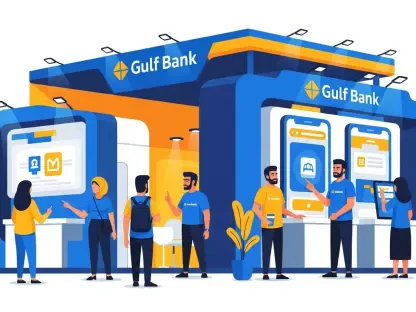I’m thrilled to sit down with Kofi Ndaikate, a renowned expert in the fintech industry whose insights into blockchain, cryptocurrency, regulation, and policy have shaped conversations around the future of finance. With a finger on the pulse of emerging trends and challenges, Kofi brings a wealth of knowledge to today’s discussion. In this interview, we’ll dive into some of the most pressing developments in the fintech space, exploring everything from dramatic stock declines and strategic acquisitions to leadership transitions and market expansions. Let’s unpack the forces driving innovation and disruption in this ever-evolving sector.
How do you interpret the massive 40% drop in Fiserv’s stock after their Q3 2025 results, and what broader implications might this have for the fintech industry?
The 40% drop in Fiserv’s stock is a stark signal of investor disappointment, reflecting deeper concerns about the company’s ability to meet expectations in a competitive market. Their adjusted earnings per share of $2.04 fell well below the anticipated $2.65, and revenue growth of just 1% to $4.92 billion missed the $5.36 billion forecast. This kind of underperformance in a major player like Fiserv can ripple through the industry, prompting investors to reassess the stability of other fintech firms. It also highlights how quickly sentiment can shift when growth projections are slashed, as Fiserv did by cutting its annual outlook from 10% to between 3.5% and 4%. This might push other companies to be more conservative with forecasts or accelerate strategic pivots to reassure stakeholders.
What do you think are the key factors behind Fiserv missing its revenue targets, and how might this reflect on their operational challenges?
Missing a revenue target by over $400 million suggests structural or market-driven hurdles. While specifics aren’t fully public, it’s likely a mix of slower adoption of their payment solutions, increased competition, or even macroeconomic pressures affecting client spending. Fiserv operates in a space where innovation cycles are short, and if they’ve lagged in rolling out new features or securing key partnerships, that could hurt their numbers. Additionally, their CEO’s acknowledgment that performance isn’t up to par points to internal inefficiencies or missteps in execution that need addressing. It’s a reminder that even giants in fintech aren’t immune to operational growing pains.
With Fiserv’s leadership shake-up, including new co-presidents and a CFO, how do you see these changes influencing their path forward?
Leadership transitions at this scale can be a double-edged sword. Bringing in fresh perspectives with the appointments of co-presidents and a new CFO could inject much-needed strategic clarity, especially after such a rough quarter. If these leaders prioritize innovation, streamline operations, or forge stronger partnerships, Fiserv might regain investor confidence. However, there’s always a risk of disruption during transitions—misaligned visions or integration challenges could slow down decision-making. I think their focus will likely be on stabilizing revenue streams and rebuilding trust, but it’ll take time to see if this team can turn the ship around.
Turning to Barclays’ acquisition of Best Egg for $800 million, what makes this deal strategically significant for their US operations?
This acquisition is a smart move for Barclays to deepen its foothold in the US consumer lending market. Best Egg’s expertise in personal loans, with over $40 billion issued to date, complements Barclays’ existing credit card and partnership-driven lending programs. It diversifies their portfolio beyond cards into a high-demand area like unsecured personal loans, which can attract a broader customer base. Plus, with Best Egg projected to facilitate $7 billion in loans in 2025, Barclays gains a scalable platform to boost growth. Strategically, it’s about capturing more of the lending market while leveraging Best Egg’s tech-driven approach to enhance efficiency.
What potential hurdles could Barclays face in integrating Best Egg, especially with regulatory approvals still pending?
Integration is never seamless, especially in a regulated space like banking. Pending regulatory approvals could delay the deal or impose conditions that limit how Barclays deploys Best Egg’s capabilities. Beyond that, aligning cultures, systems, and customer experiences between the two entities will be a challenge—Barclays is a traditional giant, while Best Egg operates with a fintech’s agility. Data migration, tech compatibility, and retaining Best Egg’s talent are practical hurdles. There’s also the risk of customer pushback if service quality dips during the transition. Barclays will need a clear roadmap to navigate these issues without losing momentum.
Looking at Monzo’s growth under TS Anil’s leadership, what do you think were the driving forces behind their customer base expanding from 4 million to over 13 million?
Monzo’s growth under TS Anil is a masterclass in user-centric fintech. Their focus on a slick, intuitive app experience, paired with transparent pricing and budgeting tools, resonated with a generation tired of traditional banking. They tapped into the digital-native demographic by prioritizing mobile-first solutions and building a community feel through social engagement and feedback loops. Strategic expansions, like offering more financial products, likely helped retain users while attracting new ones. Anil’s leadership probably fostered a culture of rapid iteration, allowing Monzo to stay ahead of competitors in meeting customer needs. Scaling to 13 million users shows they’ve cracked the code on trust and accessibility.
Monzo also saw revenue soar from £67 million to over £1.2 billion during Anil’s tenure. What strategies or innovations do you believe fueled this financial success?
That revenue jump is staggering and points to a combination of user growth and smart monetization. Monzo likely capitalized on their expanding customer base by introducing premium subscriptions or value-added services like Monzo Plus, which offer perks for a fee. Diversifying revenue through partnerships, lending products, or marketplace integrations would’ve played a role too. Their ability to achieve profitability during this period suggests tight cost control alongside revenue scaling, which isn’t easy for a neobank. Anil’s focus on sustainable growth—balancing user acquisition with per-user revenue—probably underpinned this financial leap, setting a benchmark for other challengers.
As we look at the broader fintech landscape, how do you see market entries like Bunq’s move into the US shaping competition among neobanks?
Bunq’s entry into the US with a broker-dealer license is a bold step that intensifies competition among neobanks. With over 20 million users in Europe, Bunq brings a proven model of mobile-first banking, savings tools, and now stock trading options for US clients. This diversification pressures domestic players to up their game, especially in self-directed investing and crypto services, which Bunq already offers overseas. Their pending US banking license application signals intent to go all-in, potentially challenging incumbents with innovative features and aggressive pricing. It’s a wake-up call for US neobanks to differentiate or risk losing market share to international disruptors.
What’s your take on Wealthsimple’s recent $538 million funding round and how it positions them for future growth in the wealth management space?
Wealthsimple’s raise at a $7.2 billion valuation shows strong investor confidence in their vision. Serving three million users in Canada with a doubled asset base of $100 billion, they’ve proven their model works in investing, trading, and digital assets. This $538 million injection, aimed at expanding their product roadmap across investing, spending, and credit, positions them as a serious contender in wealth management. Rolling out a credit card and eyeing strategic expansions could help them capture more of the holistic financial services market. It’s a signal they’re not just a robo-advisor anymore—they’re building a full-stack platform, which could disrupt traditional players if executed well.
Finally, what is your forecast for the fintech sector over the next few years, especially with the rapid pace of innovation and market expansions we’re seeing?
I’m optimistic but cautious about fintech’s trajectory. The next few years will likely see even faster innovation, with AI and blockchain driving new payment systems, lending models, and wealth tools. Market expansions, like Bunq’s US move, will fuel competition, pushing firms to prioritize user experience and cost efficiency. However, regulatory scrutiny will tighten as fintechs grow, especially around data privacy and financial stability—look at pending approvals for deals like Barclays-Best Egg. Consolidation will also ramp up as bigger players acquire niche innovators to stay competitive. My forecast is that fintechs balancing agility with compliance will thrive, while those overextending without strong fundamentals might stumble. It’s an exciting, high-stakes era for the industry.









